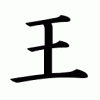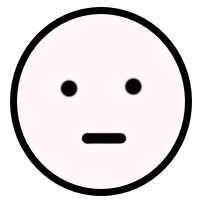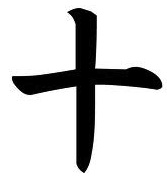To anyone reasonably well versed in traditional metaphysics, the meaning of some of the basic kanji is immediately and transparently obvious. Unfortunately, Western writers on kanji origins, armed with the beloved “progress” ideology and a total ignorance of traditional thought, work hard to obscure this. Let us try to set the record straight.
 The traditional explanation of the kanji for “monarch”[right], for example, is that of the joining of the three worlds of Heaven, Earth and Humankind. But really anyone conversant with the traditional concept of monarchy would hardly need to be told this any more than she would need to be told that a circle with two dots for eyes and a line for a mouth meant “face”.
The traditional explanation of the kanji for “monarch”[right], for example, is that of the joining of the three worlds of Heaven, Earth and Humankind. But really anyone conversant with the traditional concept of monarchy would hardly need to be told this any more than she would need to be told that a circle with two dots for eyes and a line for a mouth meant “face”.
The “monarch” kanji shows the World Axis, common to all traditions, joining the three worlds – Heavenly, (or solar/Spirtual), Human, or (lunar/psychic), Earthly, (or substantial/material) – and thus reconnecting all things with their archetypal Principles and establishing the Law of Heaven on Earth through the mediation of the Axial being (in this world, the human), headed, of course, by its principal and representative individual being, the Monarch.
This is so elementary as to be the metaphysical equivalent of ABC [more about this].
 Suppose some scholar were to tell you that the “kanji” to our left – which means face – was actually not originally a depiction of a face, but of a shirt button with holes for the thread.
Suppose some scholar were to tell you that the “kanji” to our left – which means face – was actually not originally a depiction of a face, but of a shirt button with holes for the thread.
It came to mean “face” because shirts button right up to the neck, near where the face is, but the supposed resemblance to a human face is pure coincidence, though possibly useful as a mnemonic.
The correct scholarly answer to that is: “pish-tosh”. Because even if it were true that the “face” kanji were originally a depiction of a shirt-button, it is absolutely evident that in simplifying and regularizing it, the scholars who did the work were, at the very least, utilizing a “visual pun” that clearly depicts a human face. Anyone who has an elementary-school knowledge of art can see that.
Unfortunately, many modern scholars, raised (or de-educated) in a tradition of pure materialism, do not have a knowledge even that elementary of how human beings have actually thought for most of their history.
The current kanji for “monarch” may, as we are told, have had, as one of its ancestors, a “primitive” depiction of an ax. We do not dispute that at all. The ax itself is a metaphysical symbol, and one that is actually not unconnected with the symbolism of the current “monarch” kanji – that is, its haft is a depiction of the World Axis that connects heaven and earth as well as uniting the dualities of manifest existence (and the Western hermeneutic connexion between “axis” and “ax” is by no means accidental).
In reducing the kanji to its current form, the ancient daisensei were simplifying, clarifying, and, in a sense, universalizing the metaphysical symbol to one that anyone (except a person de-educated by the modern Western ideology) can read.
In many cases, it would seem that local and particular meanings – certainly metaphysical in their primary reference , as that is the way traditional people think all over the world – were reduced to a simple and beautiful geometric metaphor (and all “abstract” thought is essentially metaphor) that reduces the metaphysical narrative to its essentials.
The fundamental error of the “scholarly” approach is to assume that the earliest local and particular form that they can find is the “real historical origin” and that therefore the later simplification is somehow “inauthentic”, or at any rate “accidental”.
This in turn is based on the idea that ancient thought was actually trying to do what modern western thought is doing (ie dealing exclusively with the accidents of the material realm), only doing it badly.
Thus the only “root” a kanji (or any other word-form) can have is merely a matter of historical accident and not of the essential metaphysical nature of the word/concept. The lack of respect for the intellectuality of the daisensei who created the current forms of the kanji is at once breathtaking in its cultural arrogance and amusingly typical of the naive provincialism of Western (and Westernized) materialistic “scholarism”.
 To take one more example, we are asked to believe that the kanji number ten (juu) is unrelated to the essential symbolism of the cross and is merely an “accidental” simplification of an earlier form, influenced by the kanji for a sewing needle.
To take one more example, we are asked to believe that the kanji number ten (juu) is unrelated to the essential symbolism of the cross and is merely an “accidental” simplification of an earlier form, influenced by the kanji for a sewing needle.
It would seem pointless to ask if it is mere coincidence that the Roman symbol for ten (X) is also a cross. The grasp of why the cross would represent ten is, in the minds of the modern scholar, so tenuous that coincidence would seem almost possible. You may wish to read this article to understand a little of the intimate connexion between four and ten, and also why ten thousand (万 man) is a numerical unit in both Chinese and Japanese.
Once we learn to discount the cultural arrogance of Western scholarism and gain some respect for the traditionally established forms of the kanji, they may begin to seem a little less mysterious. Ironically it is precisely the de-mythologization and “accidentalization” of modern Western thought that makes them seem random. In order to understand, we need to re-mythologize the kanji – or rather to treat the existing mythic/iconic structure with the respect it deserves.